
About UsThe Numismatic Bibliomania Society is a non-profit organization promoting numismatic literature. For more information please see our web site at coinbooks.org SubscriptionsThose wishing to become new E-Sylum subscribers (or wishing to Unsubscribe) can go to the following web page link MembershipThere is a membership application available on the web site Membership Application To join, print the application and return it with your check to the address printed on the application. Membership is only $15 to addresses in the U.S., $20 for First Class mail, and $25 elsewhere. For those without web access, write to: David M. Sundman, Secretary/TreasurerNumismatic Bibliomania
Society AsylumFor Asylum mailing address changes and other membership questions, contact David at this email address: dsundman@LittletonCoin.com SubmissionsTo submit items for publication in The E-Sylum, just Reply to this message, or write to the Editor at this address: whomren@coinlibrary.com
BUY THE BOOK BEFORE THE COINYou won't regret it! |
- WAYNE'S WORDS: THE E-SYLUM JULY 22, 2012
- NBS EVENTS AT THE 2012 PHILADELPHIA ANA CONVENTION
- OTHER NUMISMATIC LITERATURE EVENTS AT THE 2012 ANA CONVENTION
- KOLBE & FANNING ONLINE BOOKSTORE UPDATED
- NEW BOOK: GUIDE BOOK OF UNITED STATES CURRENCY, 5TH EDITION
- NEW BOOK: MEDALS AND PLAQUETTES IN THE ULRICH MIDDELDORF COLLECTION
- NEW BOOK: SEXO, AMOR Y DINERO: LA SEXOLOGÍA EN LA NUMISMÁTICA
- THE BANKNOTE BOOK CELEBRATES FIRST ANNIVERSARY
- ANS ANNOUNCES OCRE - ONLINE COINS OF THE ROMAN EMPIRE
- ON THE CASHLESS SOCIETY
- THE LEGAL TENDER STATUS OF THE SPANISH PILLAR DOLLAR
- NOTES FROM E-SYLUM READERS: JULY 22, 2012
- DAVID W. AKERS, 1941-2012
- INSTANT COIN COLLECTOR BOOK'S GLOSSARY OVERLY SIMPLISTIC
- HERMON MACNEIL'S STANDING LIBERTY QUARTER MODELS
- PHILADELPHIA MAN SEARCHES RIVER FOR HENNING NICKELS
- CENTRAL STATES BOOK SIGNING BOOTH AND EDUCATIONAL FORUM
- THE DAVID HIRT NUMISMATIC LIBRARY
- GERMANS HANG ON TO THE OLD DEUTSCHE MARKS
- A BRIEF HISTORY OF MONEY
- ARTIST CREATES PORTRAITS FROM BANK NOTES AND COINS
- UNPAID 450-YEAR-OLD DEBT CERTIFICATE DISCOVERED IN GERMANY
- FEATURED WEB PAGE: ECONOMICS AND MONEY MUSEUMS
WAYNE'S WORDS: THE E-SYLUM JULY 22, 2012

New subscribers this week include James Haney, courtesy of Ken Berger, Joseph Hinton, Dr. Sanjay Garg, David Pelton and Owen W. Linzmayer. Welcome aboard! We have 1,577 email subscribers, plus 183 followers on Facebook.
This week we open with a couple items on events of interest at the upcoming ANA convention, a report from numismatic booksellers Kolbe & Fanning, and announcements of three new numismatic books
Other topics include David Akers, the cashless society, the legal tender status of the Spanish Pillar dollar, coin terms, and Dave Hirt's numismatic library.
To learn more about photographic posing stands, Sex, Love and Money, and Hermon MacNeil's models for the Standing Liberty quarter dollar, read on. Have a great week, everyone!
Wayne Homren
Editor, The E-Sylum
NBS EVENTS AT THE 2012 PHILADELPHIA ANA CONVENTION
I can now confirm the following dates, times and locations for NBS events at the upcoming Philadelphia ANA (all events held at the Pennsylvania Convention Center):
Thursday, Aug 9:
NBS Symposium, 11:30am to 1:00pm, Room 106AB
NBS Board Meeting, 1:00pm to 2:30pm, Room 107A
Friday Aug 10: NBS Annual Meeting, 11:30am to 1:00pm, Room 106AB
OTHER NUMISMATIC LITERATURE EVENTS AT THE 2012 ANA CONVENTION
Joel Orosz and Len Augsburger will be present at these events:
Tuesday, Aug 7:
Money Talks Presentation by Len Augsburger and Joel J. Orosz, on The Secret History of the First U.S. Mint, 4:00pm
Thursday, Aug 9:
Book Autographing Session, 2:00pm to 3:00pm.
KOLBE & FANNING ONLINE BOOKSTORE UPDATED

Kolbe & Fanning have been busy adding hundreds of books to our online inventory, available for immediate purchase using our online bookstore at www.numislit.com. From standard references to obscure monographs, the Kolbe & Fanning website is your resource for books and catalogues covering the numismatic spectrum.
You may search for specific titles and keywords or browse the following categories:
-
 Ancient Greek Coins
Ancient Greek Coins
- Ancient Roman Coins
- Ancient Coins (Other)
- Antiquarian Titles
- Bibliography
- General References
- Medals
- Medieval Numismatics
- Modern Foreign Numismatics
- Paper Currency
- Periodicals
- Sale Catalogues
- United States Numismatics
Sign up for instant alerts when titles on particular topics have been added. We are constantly adding new titles as they become available, so check back often.
It’s all available at www.numislit.com!
NEW BOOK: GUIDE BOOK OF UNITED STATES CURRENCY, 5TH EDITION
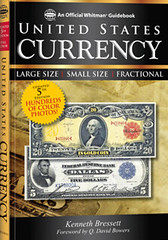 Whitman Publishing announces the release of the new fifth edition of the Guide Book of United States Currency, by Kenneth Bressett. The full-color, 352-page softcover book can be preordered online (including at Whitman.com) and will be available from booksellers and hobby retailers nationwide on August 30. It retails for $19.95.
Whitman Publishing announces the release of the new fifth edition of the Guide Book of United States Currency, by Kenneth Bressett. The full-color, 352-page softcover book can be preordered online (including at Whitman.com) and will be available from booksellers and hobby retailers nationwide on August 30. It retails for $19.95.
Bressett, longtime editor of the Guide Book of United States Coins (the “Red Book”), covers large-size, small-size, and fractional paper money in the revised and updated fifth edition. He also explores World War II issues, uncut sheets of notes, and errors, and discusses grading, supply and demand, specialization, storage, counterfeits, and other hobby topics.
“The Guide Book of United States Currency is popular among hobbyists,” said Whitman publisher Dennis Tucker. “It appeals especially to beginning and intermediate collectors. Its engaging numismatic text and solid market information are valuable for longtime collectors and dealers as well.”
Q. David Bowers, in the book’s foreword, calls it “an excellent overview and pricing guide for one of the country’s most popular hobbies.”
Features include:
- Illustrations of large-size, small-size, and Fractional Currency notes
- Listings of every series, arranged by Friedberg number
- Market prices in up to seven collectible grades
- Historical background on each series and denomination, from $1 to $10,000
- Advice on how to collect and store paper money
- Grading instructions
- Guidance on detecting counterfeits
- A glossary of collector terms
- Special sections on valuable varieties, uncut sheets, error notes, and more
# # #
Guide Book of United States Currency, 5th edition
By Kenneth Bressett. Foreword by Q. David Bowers.
ISBN 079483662-3
352 pages, 6 x 9 inches, softcover, full color, retail $19.95
For more information or to order, see: whitman.com/Inventory/Detail/Guide-Book-of-United-States-Currency-5th-Edition+0794836623
NEW BOOK: MEDALS AND PLAQUETTES IN THE ULRICH MIDDELDORF COLLECTION
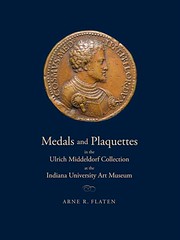 Medals and Plaquettes in the Ulrich Middeldorf Collection at the Indiana University Art Museum
Medals and Plaquettes in the Ulrich Middeldorf Collection at the Indiana University Art Museum
15th to 20th Centuries
Arne R. Flaten
Distribution: World
Publication date: 6/26/2012
Format: cloth 248 pages, 670 color illus., 20 b&w illus.
9 x 12
ISBN: 978-0-253-00116-0
Spanning six centuries and seven countries, the Middeldorf Collection assembled by the late eminent art historian Ulrich Middeldorf provides an extraordinary overview of major personalities and of political, social, cultural, and religious events as depicted in more than 350 medals and plaquettes. Illustrated in full color and accompanied by extensive documentation are commemorations of kings, queens, emperors, poets, composers, physicians, artists, inventors, popes, cardinals, and bishops. Papal annual and jubilee medals and delightful French reliefs from the Belle Époque complement medals from the eras of Louis XIV and XV, Napoleon, and the Risorgimento. Highlights of the collection are Italian medals from the 17th century and later periods that until recently have received little scholarly attention.
To order, see: www.iupress.indiana.edu/product_info.php?products_id=155593
To read the earlier E-Sylum article, see: NEW BOOK: MEDALS AND PLAQUETTES FROM THE MIDDELDORF COLLECTION (www.coinbooks.org/esylum_v13n23a07.html)
NEW BOOK: SEXO, AMOR Y DINERO: LA SEXOLOGÍA EN LA NUMISMÁTICA
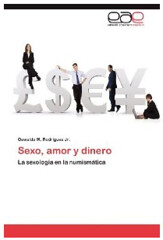 "Sexo, amor y dinero: La sexología en la numismática"
"Sexo, amor y dinero: La sexología en la numismática"
by Oswaldo M. Rodrigues Jr. (Author)
Paperback: 100 pages
Publisher: Editorial Académica Española (April 6, 2012)
Language: Spanish
ISBN-10: 3848468603
ISBN-13: 978-3848468607
Product Dimensions: 8.7 x 5.9 x 0.2 inches
Shipping Weight: 6.9 ounces
To order the book from Amazon, see:
www.amazon.com/Sexo-amor-dinero-sexolog%C3%ADa-numism
%C3%A1tica/dp/3848468603/ref=sr_1_120
THE BOOK BAZARRE
THE BANKNOTE BOOK CELEBRATES FIRST ANNIVERSARY

The Banknote Book—a new catalog of world notes—marked its first anniversary in June 2012. After its first full year of availability, The Banknote Book now comprises 130 country-specific chapters available as individual high-resolution PDF files. This represents a total of 1,400+ pages covering 11,000+ types and varieties, including 2,000+ notes not listed in Krause’s “Pick” catalog, officially known as the Standard Catalog of World Paper Money (SCWPM).
Author Owen W. Linzmayer is pleased with reaching this milestone. “It is particularly satisfying to collaborate with a wide range of domain experts around the globe to help create a new catalog, and it keeps getting bigger and better every week.”
Subscriber Russ Smith is also thrilled with the results. “The Banknote Book goes well beyond my expectations,” said Smith. “The graphics, layout, signatures, descriptions, presentation, source references, and more are truly appreciated. The Banknote Book far surpasses Pick and other general reference works.”
Each chapter of The Banknote Book includes detailed descriptions and background information, full-color images, and accurate valuations. The Banknote Book also features:
- Sharp color images of note’s front and back without overlap
- Face value or date of demonetization if no longer legal tender
- Specific identification of all vignette elements
- Security features described in full
- Printer imprint reproduced exactly as on note
- Each date/signature variety assigned an individual letter
- Variety checkboxes for tracking your collection and want list
- Red stars highlight the many notes missing from the SCWPM
- Date reproduced exactly as on note
- Precise date of introduction noted when known
- Replacement note information
- Signature tables, often with names and terms of service
- Background information for historical and cultural context
- Details magnified to distinguish between note varieties
- Bibliographic sources listed for further research
The Banknote Book is sold by subscription or individually by chapter, and payments may be made online or by mail. The $99 annual subscription entitles the buyer to every chapter currently available as well as everything published—or revised—during the next 12 months.
The chapters—which serve as stand-alone catalogs for individual countries—are priced based upon their page count:
- Fewer than 5 pages: $0.99
- 5 to 9 pages: $4.99
- 10 or more pages: $9.99
Several shorter chapters are available as free samples, and new releases and revisions are published regularly.
Furthermore, all 130 chapters published to date are currently available as a two-volume, black-and-white paperback set. For details on the printed version, interested parties should visit Lulu.com and search for “Linzmayer” in Books.
For more details, to set up an interview, or to request a review copy, please contact Owen W. Linzmayer via email owen@banknotenews.com, or call +1 (415) 519-1418.
About the author: Owen W. Linzmayer is an avid collector of world paper money and the former editor of the International Bank Note Society's quarterly publication, the IBNS Journal, which the American Numismatic Association awarded second place in the specialty clubs category of the ANA’s 2008 Club Publications Contest. Linzmayer also received the IBNS Literary Award Honourable Mention in 2011 for his article “Eritrean Banknotes—The Birth of the Nakfa.” In addition to writing The Banknote Book, he also publishes BanknoteNews.com, the #1 web site devoted to breaking news about international paper & polymer money.
ANS ANNOUNCES OCRE - ONLINE COINS OF THE ROMAN EMPIRE

Today, in collaboration with New York University’s Institute for the Study of the Ancient World, the ANS launches a major new tool to aid in the identification, research and cataloging of the coins of the ancient world.
OCRE (Online Coins of the Roman Empire) is an attempt to present, in an easily searchable form, all the varieties of the coinage issued by the emperors of ancient Rome. Phase 1, which is launched today, covers the coinage of the first emperors, from Augustus to Hadrian (27 BC – AD 138).
The site presents a basic description of each published variety based on the ANS’ collection catalogue (MANTIS). Each of these type descriptions is linked to specimens present in the ANS collection and, where available, to images. Searches are made straightforward through a series of facets, presented in a way that will already be familiar to users of other ANS search tools.
Traditional searches of familiar numismatic categories such as obverse and reverse legends and types are provided, in the hope that OCRE will provide an identification tool useful to collectors, dealers, curators and field archaeologists. Subject searches have also been provided to allow more general researchers to find personifications, deities and portraits.
“OCRE is yet another example of the way that the ANS is both presenting numismatic material to those knowledgeable in the field, as well as expanding the accessibility of numismatic material to broader audiences”, notes ANS Executive Director Ute Wartenberg Kagan. “Building on years of curatorial work to catalogue our coins, we hope that our new web-based tools will make that work available to as broad an audience as possible, in as flexible a way as possible”.
OCRE project manager and Roman specialist, Gilles Bransbourg describes the advance that is heralded by OCRE: “OCRE is a leap forward for numismatists, historians and archaeologists alike. Until now, any research into Roman imperial coinage had to rely on paper-based catalogues, online auctions or the very few collections available online. OCRE offers a single, central online catalogue that allows users to view, download and organize digitized information covering the entire history of the Roman imperial coinage. T
To access OCRE, see: numismatics.org/ocre/
ON THE CASHLESS SOCIETY
Dr K.A. Rodgers of New Zealand writes:
In the current crop of predictions surrounding a future cashless society, I can’t help but hear echoes of the prognostications some decades ago about an impending paperless office. I have a sneaking suspicion that just as we find hard copies essential to our lives today we will have a need in the foreseeable future for some form of hard cash.
I have noted that at the blunt end of the globe that although electronic EFTPOS and credit card transactions have soared in past decades so has the amount of folding money and coinage required in society. There have been changes in the way cash is used but it is still needed.
On a practical level I have stood outside a supermarket where the internet has gone off line, and yet another where a power outage occurred. Hard cash was the answer to purchases on both occasions. Those of us who had it went home with a smile on their face. Those relying on plastic stayed hungry. And when the earthquake bowled Christchurch in general and its CBD in particular, including all the cash machines, the Reserve Bank of New Zealand rode into town with bags of hard moolah to ensure folk could buy essentials such as bread and milk.
These experiences suggest that electronic transactions are still vulnerable on two counts: security of power supply and security of internet. Both need to be present where a transaction is taking place and where it is being recorded and processed. Sadly in our modern society these can’t be guaranteed 24/7 for a number of reasons. Any society that opts to go principally for electronic transactions makes puts itself at risk.
And I get twitchy about the potential cost of electronic transactions. Already our credit cards incur a charge at POS. And not just from the banks; some retail outlets are beginning to charge extra for card use. PayPal, of which I am a fervent user, costs for the convenience although no credit is involved. How long will it be before someone decides to slap a charge on each electronic transaction? Businesses? Banks? Or even our beloved governments by way of a transaction tax. It has already been mooted. In particular, for those of us stuck with a good-and-services-tax/value-added tax, I get very twitchy at the thought of paying a tax on a tax.
To read the complete article, see: AN OPEN LETTER TO THE NEW ANA EXECUTIVE DIRECTOR (www.coinbooks.org/esylum_v15n30a21.html)
THE LEGAL TENDER STATUS OF THE SPANISH PILLAR DOLLAR
Ken Berger writes:
In the last E-Sylum David Ganz stated "The act of Feb. 21, 1857, (ch. 56, 11 Stat. 163 ) determined that the legal tender of the Spanish pillar dollar continued but for other foreign coins, legal tender status was denied."
I read this act and section 3 states:
"Sec. 3. And be it further enacted, That all former acts authorizing the currency of foreign gold or silver coins, and declaring the same a legal tender in payment for debts, are hereby repealed; . . .."
Based upon my reading of this section, all foreign coins (which would include the Spanish pillar dollar) are no longer legal tender. I ask therefore, based upon this section, how the legal tender status of the Spanish pillar dollar was continued?
Dave Lange writes:
I'm not a lawyer, but I nevertheless have to challenge a statement that David Ganz made in his essay about the meaning of legal tender. He said that the Act of February 21, 1857 permitted the Spanish eight-reales coins to remain legal tender when all other foreign coins lost that status. This didn't sound right to me, so I reread the act in its entirety.
In fact, all acts regarding the legal tender status of foreign coins in the USA were repealed under the 1857 law. This effectively ended the legal tender status of such coins. While the Spanish coins and those of Spain's former New World colonies were thus no longer lawful money, a provision was made for the redemption of existing supplies of fractional silver coins, their sheer numbers in circulation making this a desirable means of retiring them. These coins could be used in payment solely at the U. S. Treasury, federal post offices and federal land offices, but they were to be received only at a discounted rare. The two reales, one real and half real coins would be accepted as 20 cents, 10 cents and five cents, respectively. They could not be paid out by these offices, but were instead to be forwarded to the U. S. Mint for recoinage into federal money. As no mention of the four reales coin was made, it must have been driven from circulation years earlier by the vast numbers of federal half dollars minted.
The 1857 law also permitted the Mint to pay out the new copper-nickel cents in exchange for the Spanish coins at their nominal circulating rates of 25 cents, 12.5 cents and 6.25 cents, respectively. Thus, the old Spanish coins were worth more in exchange for cents than in payment at federal offices or deposit at the Treasury. This encouraged holders of the coins to purchase and circulate the new cents, thereby facilitating retirement of both the Spanish coins and the old copper cents and half cents. The latter two were also redeemable in new cents. This provision was to expire in two years from the effective date of the act, but it was extended in 1859 when the supply of obsolete coins wasn't disappearing quickly enough.
Ginger Rapsus adds:
The latest issue of The E-Sylum was one of the best I've read. I especially enjoyed the article on legal tender. Reminds me of when I got into an argument with a Pace bus driver over using dollar coins for bus fare.
A silly question...did the Coinage Act of 1965 legalize the 1933 $20 gold?
To read the complete article, see: DAVID GANZ ON LEGAL TENDER AND SPENDING MONEY (www.coinbooks.org/esylum_v15n30a11.html)
NOTES FROM E-SYLUM READERS: JULY 22, 2012
More on the Good Samaritan Shilling
Alan Weinberg writes:
The British Museum has a Good Samaritan silver shilling in their cabinet that grades Fair - About Good condition - smooth clean wear, no damage - so someone went to a lot of trouble to make this "fabrication" look legitimate. I believe the pedigree is the Pembroke Collection going back to the early 1800's.
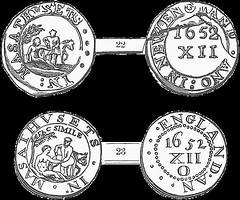
To read the earlier E-Sylum article, see: BOOK REVIEW: THE SECRET OF THE GOOD SAMARITAN SHILLING (www.coinbooks.org/esylum_v15n30a05.html)
Australian Ballet Coin
P.K. Saha forwarded this image of a new coin commemorating 50 years of the Australian ballet. I like it... makes me want to dance...
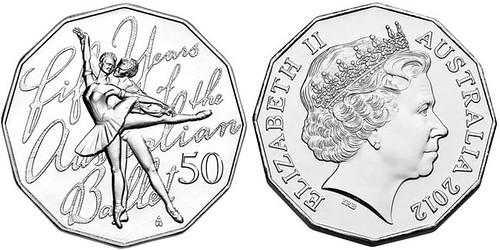
How Publishers Handle Errata These Days
Regarding the missing sections of the Standard Catalog of World Coins 1901-2000 being published online, Ken Berger writes:
Years ago a decent publisher would have supplied the purchasers of the book with an addendum free of charge for the missing sections (especially with such major sections missing). By requiring the purchaser to download files, the publisher saves the expense of printing and mailing the missing sections and instead shifts the burden (& the expense) to the purchaser. It may have been a true error on the publisher's part but I can see it becoming more & more common since it saves the publisher money in the long run.
To read the earlier E-Sylum article, see: NOTES FROM E-SYLUM READERS: JULY 15, 2012: Missing Sections of SCWC 1901-2000 (www.coinbooks.org/esylum_v15n30a08.html)
Errors in the July 15, 2012 Issue
Joe Boling writes:
Thian's name is misspelled twice in the Wilsons' review (first two instances - Thain). Their reference to the AGO as the Attorney General's Office should be Adjutant General's Office. You might want to fix those in your archive.
To read the earlier E-Sylum article, see: BOOK REVIEW: HISTORY OF COLLECTING CONFEDERATE STATES PAPER MONEY (www.coinbooks.org/esylum_v15n30a04.html)
Jim Duncan writes:
The Crusader gold pieces - should they be DINARS and parts? They are called both dinaR and dinaL in the press report - mis-print maybe. (Dinal certainly isn't in Frey - who I trust).
To read the earlier E-Sylum article, see: CRUSADERS' GOLD COIN HOARD FOUND IN ISRAEL (www.coinbooks.org/esylum_v15n30a16.html)
Posing Stands
Last week I asked about the photographer's posing stand seen in the image with Monroeville Dickeson. Nick Graver writes:
Here is a beautiful illustration of a posing stand, but they have the head clamp turned on end (vertical) rather than in the position of use, grasping a subject's head behind the ears.
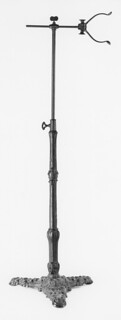

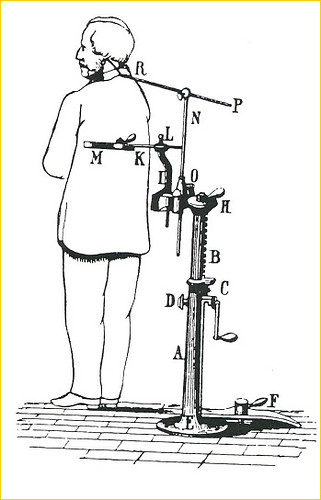
To read the earlier E-Sylum article, see: MORE ON MONTROVILLE DICKESON (www.coinbooks.org/esylum_v15n30a07.html)
DAVID W. AKERS, 1941-2012
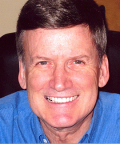 David Warren Akers, a devoted husband, father, brother, uncle, and friend passed away quietly at home on July 11th, surrounded by loved ones. David was born in Seattle, Washington on September 26, 1941, to Bryon and Beatrice Akers. He graduated from Franklin High School, received his Bachelors of Science Degree in Mathematics from the University of Notre Dame and Master's Degree from Oregon State University. He served in Viet Nam as a first lieutenant in the Army, then first as a forward observer and later as Battery Commander. He received the Purple Heart and Military Commendation Medal for Military Merit in 1966.
David Warren Akers, a devoted husband, father, brother, uncle, and friend passed away quietly at home on July 11th, surrounded by loved ones. David was born in Seattle, Washington on September 26, 1941, to Bryon and Beatrice Akers. He graduated from Franklin High School, received his Bachelors of Science Degree in Mathematics from the University of Notre Dame and Master's Degree from Oregon State University. He served in Viet Nam as a first lieutenant in the Army, then first as a forward observer and later as Battery Commander. He received the Purple Heart and Military Commendation Medal for Military Merit in 1966.
Upon his return from Viet Nam, he finished graduate school and married Sharron in 1969, and went on to teach mathematics at Saint Martin's College in Olympia. In 1972, he went to work for Paramount International Coin Corporation where he worked his way up to President. He traveled all over the world visiting their offices in Europe, meeting with representatives of foreign governments regarding their coin programs, reviewing private collections for auctions, and speaking before various professional groups on the value of coins as an investment.
Coins were his passion since he was eight years old, and he felt so lucky to be able to turn his love of coins and their history into his profession. He started his own rare coin business in 1987, and ran major auctions in Baltimore and New York City. The rarest of rare coins crossed his desk frequently. He became a renowned numismatist, having studied coins for so many years, authored eight books on coins, having received many numismatic awards. Even the United States Treasury Department would call him to authenticate a coin!
His family and friends remember his zest for life, his warm sense of humor, his bright smile, and his infectious laugh. They will also cherish the memories of his sharp analytical mind, his phenomenal memory and extensive reading, which enabled him to recall information on most any subject. But most of all, he will be remembered for his honesty, integrity, and being just a nice guy.
David is survived by his wife of 43 years, Sharron, and his daughter, Heather Anne. Also his sister, Joan Booms, his nephew, Douglas Booms, and his wife Catherine, brother in law, Mark Osterhout all of Seattle, Washington and his faithful dog, Buster. A memorial service to celebrate the memory of his life will be held at the First United Methodist Church, 1500 South Kanner Highway, Stuart, FL, 34995 on Wednesday, July 25th at 3:00 PM.
In lieu of flowers, the family has asked for donations to be made in his name to the Hibiscus Children's Foundation, 2400 NE Dixie Highway, Jensen Beach, FL 34957. All Condolences at www. aycockfuneralhome.net. All arrangements are entrusted to Aycock Funeral Home, Stuart, FL.
To read the complete obituary, see:
David Warren Akers
(www.legacy.com/obituaries/tcpalm/obituary.aspx?n=
david-warren-akers&pid=158635397&fhid=10593)
Peter Preston-Morley writes:
I was sorry to read of the death of David Akers in the latest E-Sylum. He was President of Paramount when I worked for the London office of the company in the mid 70s and I remember his occasional visits to the UK at that time, when he would roll his sleeves up and get involved with whatever project was on the go, whether it was mailing out Trinidad & Tobago proof sets with our mail man Mike, previewing US coins in London auctions with me, going to the printers and overseeing whatever catalogue or mail shot that was in the press – David was interested in it all.
I last had contact with him at the time of the Pittman sales when he was, as ever, very forthcoming with information that he chose not to put in the printed catalogues. He will be a sad loss, but his works on US gold remain a fine testament to one of the 'old school' of professional numismatists.
To read the earlier E-Sylum article, see: DOUG WINTER REMEMBERS DAVID AKERS (www.coinbooks.org/esylum_v15n30a06.html)
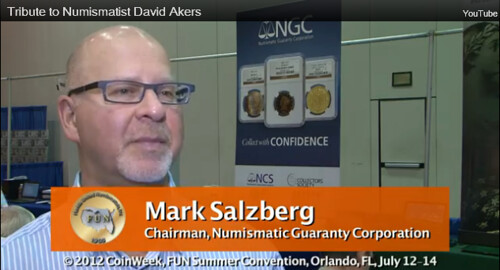
To view the David Akers video, see: www.coinweek.com/featured-news/a-video-tribute-to-numismatist-david-akers/
Tim Shuck adds:
For those who want Doug Winter's articles sooner, he posts them on raregoldcoins.com usually a few days before they are reposted on other coin news sites. He has also an RSS signup (under the Articles tab) for direct notification when they're made available.
INSTANT COIN COLLECTOR BOOK'S GLOSSARY OVERLY SIMPLISTIC
I have studied 45 numismatic dictionaries and encyclopedias in all languages. Albert Frey's Numismatic Dictionary is the old standby in English. It ran serially in the American Journal of Numismatics and was published in book form by ANS in 1917. It is somewhat overburdened with coin denomination names and light on technical numismatic terms but it has stood the test of time and been reprinted twice, once with Mark Salton''s "Glossary of Numismatic Terms" in five languages.
My favorite foreign language numismatic dictionary is Friedrich von Schroetter's Worterbuch der Muzkunde, published 1930. The author was the keeper of the Berlin coin cabinet who had the assistance of five numismatists who contributed entries. Great German scholarship by all six. Like Frey, it has been reprinted twice, once by Argonaut in Chicago 1967, and in Berlin 1970.
I have also studied glossaries of numismatic terms in 21 numismatic works. The best is the Glossary in Walter Breen's Complete Encyclopedia of U.S. and Colonial Coins published 1988. (See the 582-entry Glossary, pages 695-711). Breen had published many of the terms previously, the latest was in Walter Breen's Encyclopedia of United States and Colonial Proof Coins, published in 1977 (that glossary had 230 terms). So he expanded and polished that list for the 1988 edition, more than doubling the terms defined.
Also I have examined glossaries of numismatic terms on the internet. In contrast to Breen and some of the full book dictionaries and encyclopedias these internet glossaries are the worst. Lots of misinformation and uninformed definitions. I believe this is due to the fact these are not edited. Anyone can put anything on the internet.
This week there appeared in my mail box a message from KP Publications that illustrated a book they published in 2009, The Instant Coin Collector, by Arlyn G. Sieber. They selected 36 numismatic terms as "The Language of Coins" from that book.
I recognize the author was writing for the beginning collector. However, comparing these definitions to what has been accepted in the field we see-- not misinformation -- but "fuzzy" definitions. That beginning collector will have to learn the more accurate meanings later. Wouldn't it had been better to give him the precise meaning right up front?
There are numerous terms in numismatics that have established fuzzy, inexact or misnomer status in active use today. These include: die trial, pattern, carbon spot, graining, lint marks, milled edge, and oxidation, among others. This fuzzy status results from not learning the precise meaning in the first place.
Sieber describes "Proof" for example, as "a type of coin produced especially for sale to collectors." This overlooked an opportunity to describe "proof surface" and how it is produced. Vital data for every coin enthusiast.
In a word -- okay two words -- I would describe his definitions as "overly simplistic." If you wish to review those chosen 36 basic coin collecting terms, click on:
To read the complete article, see: The Language of Coins (www.numismaster.com/ta/numis/Article.jsp?ad=article&ArticleId=25485&et_mid=569290&rid=233114635)
THE BOOK BAZARRE
HERMON MACNEIL'S STANDING LIBERTY QUARTER MODELS
 Four different models crafted by Hermon A. MacNeil during his creation of the Standing Liberty quarter dollar design are slated to be auctioned by Stack’s Bowers Galleries during the American Numismatic Association World’s Fair of Money in Philadelphia, held Aug. 7 to 12.
Four different models crafted by Hermon A. MacNeil during his creation of the Standing Liberty quarter dollar design are slated to be auctioned by Stack’s Bowers Galleries during the American Numismatic Association World’s Fair of Money in Philadelphia, held Aug. 7 to 12.
Two of the models are composed of plaster; the other two models are made of bronze.
The two plaster pieces — a bas-relief model depicting MacNeil’s Standing Liberty, Bare Breast, or Type I, obverse design, and a bas-relief model of MacNeil’s Flying Eagle, Stars Below Eagle, or Type II, reverse design — have been consigned to auction by descendents of MacNeil’s second wife, Cecelia W. (Muench) MacNeil and are making their first-ever auction appearance.
The bas-relief bronze casts — one an obverse design featuring dolphins and the other an alternate Flying Eagle reverse design — were previously sold and purchased in Stack’s May 2008 Minot Collection sale.
Historian and numismatic researcher Roger Burdette, author of the three-volume work Renaissance of American Coinage, has composed catalog descriptions for the four models.
Both MacNeil bronze models were previously sold May 21, 2008, by Stack’s. The obverse model, Lot 1378, realized $120,750. The reverse model, Lot 1379, realized $21,850.
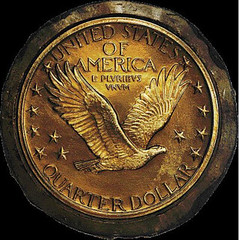
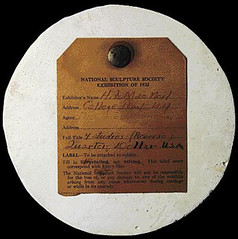
To read the complete article, see: MacNeil models to appear in ANA auction (www.coinworld.com/articles/macneil-models-to-appear-in-ana-auction/)
PHILADELPHIA MAN SEARCHES RIVER FOR HENNING NICKELS
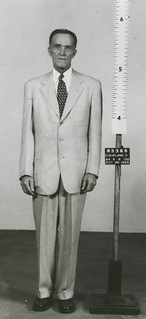 He was an enigma to the authorities and a curiosity to collectors, a man who could have made bundles with his brains.
He was an enigma to the authorities and a curiosity to collectors, a man who could have made bundles with his brains.
But not all of Francis L. Henning's plans were foolproof or legal, and he fled South Jersey in 1955 with the feds on his tail, dumping buckets full of shiny evidence in local waterways. On Oct. 28 that year, Henning, looking both distinguished and defeated in a light suit, stood for a mug shot in Cleveland, where he was making $700 a month as a mechanical engineer — more than twice the national average for the era.
Henning was a counterfeiter who strategically dreamed small, it seems, to fly under the radar of the agency he figured would be looking for fakes: the Secret Service. Henning made hundreds of thousands of fake nickels in a machine shop in rural Erial, Camden County, all by himself, using a 250,000-pound press and sheets of cupronickel that cost him thousands of dollars. Then he'd launder the money for real bills at local banks, posing as a vending-machine operator, the Associated Press reported after his arrest.
Now, almost 60 years later, Henning's name still carries some notoriety in the coin-collecting community — the same eagle-eyed group that first noticed Henning's "slight mistake." A local banker and member of a Camden County coin club alerted authorities after he noticed Henning had omitted a "p" found on 1944 nickels — a mint stamp that indicated the nickel would come from Philadelphia. "He made one slight mistake and it tripped him up," a Secret Service agent told the AP.
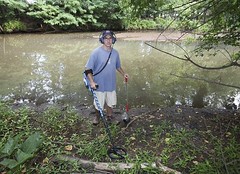 The "Henning nickel," as it's known among hobbyists, has become a bit of an obsession for a mild-mannered advertising rep from Cherry Hill who spends most of his free time with a metal detector. Neil Schwartz could buy a Henning nickel, probably for less than $50, but he's looking elsewhere: a stretch of muck in the Cooper River that he asked the Daily News not to divulge.
The "Henning nickel," as it's known among hobbyists, has become a bit of an obsession for a mild-mannered advertising rep from Cherry Hill who spends most of his free time with a metal detector. Neil Schwartz could buy a Henning nickel, probably for less than $50, but he's looking elsewhere: a stretch of muck in the Cooper River that he asked the Daily News not to divulge.
"It's not for the money," he said over French toast at Ponzio's Diner in Cherry Hill last month. "It's for the thrill of it."
To read the complete article, see: Stalking the Cooper River for thousands of fake nickels (articles.philly.com/2012-07-16/news/32698938_1_nickels-secret-service-mechanical-engineer)
CENTRAL STATES BOOK SIGNING BOOTH AND EDUCATIONAL FORUM
Kevin Foley, General Chairman of the Central States Numismatic Society’s 74th Anniversary Convention, to be held April 22-27, 2013 at the Schaumburg Renaissance Hotel and Convention Center in northwest suburban Chicago, and Ray Lockwood, Education Director for the 2,500 member organization, have announced that the CSNS convention will feature an authors’ book signing booth. In a joint statement, the CSNS officials said, “Our book signing booth will be open to any numismatic author on a complimentary basis to meet with the public and sign copies of their books during a pre-arranged time slot.
Last year we hosted a highly successful Civil War Educational Forum and will be expanding that feature of our convention to include nine sessions. A number of our presenters are recognized researchers in the academic world. The signing booth will give our attendees an opportunity to meet with our Civil War Educational Forum presenters one on one and obtain autographed copies of their published works. In addition, the signing booth will be open to numismatic authors to use during an assigned time to meet with the public, discuss their research interests and autograph copies of their books.”
Authors interested in participating should contact either Convention Chairman Kevin Foley by phone at (414) 807-0116 or e-mail at kfoley2@wi.rr.com to arrange for a time slot assignment. Education Director Ray Lockwood will also be available to assign authors’ time slots. He can be reached by phone at (765) 664-6520 or via e-mail at sunrayofmarion@aol.com.
Lockwood added, “Our book signing booth is yet another in the expanding universe of Central States Numismatic Society educational initiatives. We have a highly popular DVD distribution program under which we give educational DVD’s to our member clubs on a request basis without any charge. In addition, we have a generous library donation subsidy program where we give library donation grants of $500 to member clubs applying just $100 of their own funds to make numismatic book donations to school, university or public libraries in their communities.”
Lockwood continued, “We also sponsor, in cooperation with local host clubs, free standing numismatic lecture programs during which we bring nationally recognized numismatic researchers and speakers to appear before our hosts for a series of lectures about various numismatic subjects. Our Civil War Educational Forum, which will be in its second year at our April 22-27, 2013 74th Anniversary Convention at the Schaumburg Renaissance Hotel and Convention Center, was successful beyond our wildest dreams and served as the inspiration for General Chairman Foley and myself to launch our book signing booth at the upcoming convention. I know that many numismatists also collect numismatic literature. Having access to autographed works signed by our authors and forum presenters will be an enhancement to their collecting interests and overall convention experience.”

THE DAVID HIRT NUMISMATIC LIBRARY
Dave Hirt writes:
I enjoyed last week's post as usual. The review on the Confederate money book impressed so much that I ordered a copy. I have a copy of the John C. Browne sale in my library. I am not at home to pull it off the shelf, however my computer notes state it is scarce, not being listed in the ANS catalog, also not in the Champa sale.
Since I suggested that readers submit pictures of their libraries, perhaps I can get the ball rolling. Here are a couple pictures of mine. I recently bought a nice large sectional bookcase that I filled with auction catalogs that were stored elsewhere, but I do not have a picture in this computer.
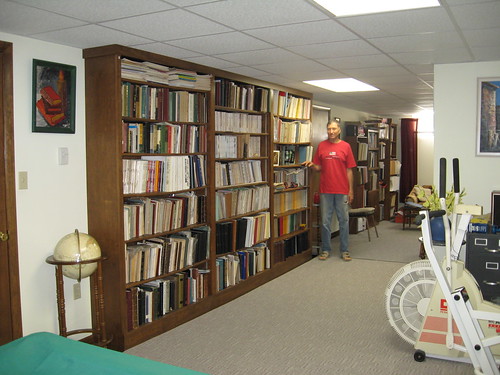
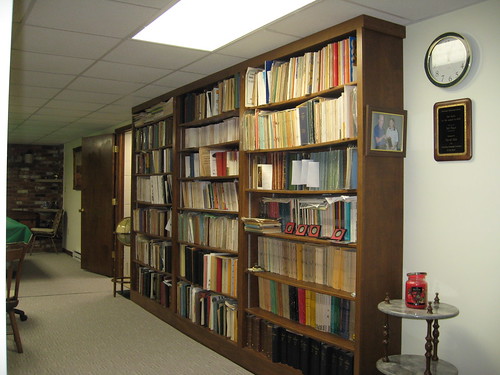
GERMANS HANG ON TO THE OLD DEUTSCHE MARKS
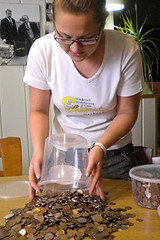 Shopping for pain reliever here on a recent sunny morning, Ulrike Berger giddily counted her coins and approached the pharmacy counter. She had just enough to make the purchase: 31.09 deutsche marks.
Shopping for pain reliever here on a recent sunny morning, Ulrike Berger giddily counted her coins and approached the pharmacy counter. She had just enough to make the purchase: 31.09 deutsche marks.
"They just feel nice to hold again," the 55-year-old preschool teacher marveled, cupping the grubby coins fished from the crevices of her castaway living room sofa. "And they're still worth something."
Behind the counter of Rolf-Dieter Schaetzle's pharmacy in this southern German village lay a tray full of deutsche mark notes and coins—a month's worth of sales.
Germans have yet to give up on the euro. But as Europe's debt crisis rages on, many are indulging their nostalgia for the abandoned mark by shopping with it again—and retailers are happily going along.
 As defunct currencies go, "die gute alte D-mark," or "the good old D-mark," as it is still affectionately called, is far from dead. Germans officially traded in the currency for euro bills and coins on Jan. 1, 2002, and the mark immediately ceased to be legal tender. But 13.2 billion marks—worth €6.75 billion ($8.3 billion)—remain tucked in mattresses, old prayer books, coat pockets or otherwise in circulation, according to the Bundesbank, more lucre than the euro bloc's 16 other ex-currencies combined.
As defunct currencies go, "die gute alte D-mark," or "the good old D-mark," as it is still affectionately called, is far from dead. Germans officially traded in the currency for euro bills and coins on Jan. 1, 2002, and the mark immediately ceased to be legal tender. But 13.2 billion marks—worth €6.75 billion ($8.3 billion)—remain tucked in mattresses, old prayer books, coat pockets or otherwise in circulation, according to the Bundesbank, more lucre than the euro bloc's 16 other ex-currencies combined.
Unlike neighbors such as Italy and France, which let their liras and francs officially expire over the past year, Germany never set a deadline for exchanging its old money for euros. So, if they decide to accept marks, retailers and other businesses can still exchange them at German central bank branches.
To read the complete article, see: Who Needs the Euro When You Can Pay With Deutsche Marks? (online.wsj.com/article/SB10001424052702304373804577520930784840596.html)
A BRIEF HISTORY OF MONEY
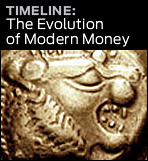 In the 13th century, the Chinese emperor Kublai Khan embarked on a bold experiment. China at the time was divided into different regions, many of which issued their own coins, discouraging trade within the empire. So Kublai Khan decreed that henceforth money would take the form of paper.
In the 13th century, the Chinese emperor Kublai Khan embarked on a bold experiment. China at the time was divided into different regions, many of which issued their own coins, discouraging trade within the empire. So Kublai Khan decreed that henceforth money would take the form of paper.
It was not an entirely original idea. Earlier rulers had sanctioned paper money, but always alongside coins, which had been around for centuries. Kublai’s daring notion was to make paper money (the chao) the dominant form of currency. And when the Italian merchant Marco Polo visited China not long after, he marveled at the spectacle of people exchanging their labor and goods for mere pieces of paper. It was as if value were being created out of thin air.
Kublai Khan was ahead of his time: He recognized that what matters about money is not what it looks like, or even what it’s backed by, but whether people believe in it enough to use it. Today, that concept is the foundation of all modern monetary systems, which are built on nothing more than governments’ support of and people’s faith in them. Money is, in other words, a complete abstraction—one that we are all intimately familiar with but whose growing complexity defies our comprehension.
To read the complete article, see: A Brief History of Money (spectrum.ieee.org/at-work/innovation/a-brief-history-of-money/0)
ARTIST CREATES PORTRAITS FROM BANK NOTES AND COINS
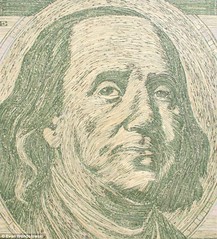 An artist has put bags of old shredded money to an unusual use – by making portraits of politicians and celebrities out of them.
An artist has put bags of old shredded money to an unusual use – by making portraits of politicians and celebrities out of them.
Evan Wondolowski used thousands of paper strips from shredded U.S. Federal Reserve notes to make a stand against greed with his new collection of images.
The ‘currency collage’ includes four portraits of President Barack Obama, rapper Biggie Smalls, political satirist Stephen Colbert and United States founding father Benjamin Franklin, all made out of money.
He said he bought shredded from eBay, to create the money-made portraits, which each take up to a month create.
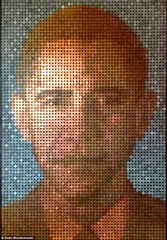 Obama’s portrait is a different from the rest of the collection, and instead of cash it’s made out of United States Lincoln head pennies.
Obama’s portrait is a different from the rest of the collection, and instead of cash it’s made out of United States Lincoln head pennies.
To read the complete article, see:
Money maketh the man: Artist creates impressive portraits of celebrities and politicians from bank notes and coins
(www.dailymail.co.uk/news/article-2176885/Evan-Wondolowski-Artist
-creates-impressive-portraits-celebrities-politicians-bank-notes-coins.html)
UNPAID 450-YEAR-OLD DEBT CERTIFICATE DISCOVERED IN GERMANY
The sleepy hamlet of Mittenwalde in eastern Germany could become one of the richest towns in the world if Berlin were to repay it an outstanding debt that dates back to 1562.
A certificate of debt, found in a regional archive, attests that Mittenwalde lent Berlin 400 guilders on May 28 1562, to be repaid with six percent interest per year.
According to Radio Berlin Brandenburg (RBB), the debt would amount to 11,200 guilders today, which is roughly equivalent to 112 million euros ($136.79 million).
Adjusting for compound interest and inflation, the total debt now lies in the trillions, by RBB's estimates.
Town historian Vera Schmidt found the centuries-old debt slip in the archive, where it had been filed in 1963. Though the seal is missing from the document, Schmidt told Reuters that she was certain the slip was still valid.
"In 1893 there was a debate in which the document was examined and the writing was determined to be authentic," Schmidt said.
Schmidt and Mittenwalde's Mayor Uwe Pfeiffer have tried to ask Berlin for their money back. Such requests have been made every 50 years or so since 1820 but always to no avail.
To read the complete article, see:
450-year-old debt. Trillions owed. But will German village get repaid?
(www.csmonitor.com/Business/Latest-News-Wires/2012/0718/450-year-old-debt
.-Trillions-owed.-But-will-German-village-get-repaid)
To read the original story in German, see:
Berlin schuldet Mittenwalde ein Vermögen
(www.berliner-zeitung.de/berlin/jahrhunderte-alter-schuldschein-berlin
-schuldet-mittenwalde-ein-vermoegen,10809148,16110222.html)
FEATURED WEB PAGE: ECONOMICS AND MONEY MUSEUMS
This week's Featured Web Page about Economics and Money Museums is suggested by David Klinger. Thanks!This international list of economics and money museums is classified by geographical areas: European System of Central Banks (ESCB) museums and other national museums. These museums, which are devoted to the role of central banks, the history of money, the exploration and discovery of different aspects of the economy, offer pages or whole web sites given over to their pedagogical content and collections and exhibition tour.
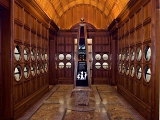
www.citedeleconomie.fr/Museums,149
